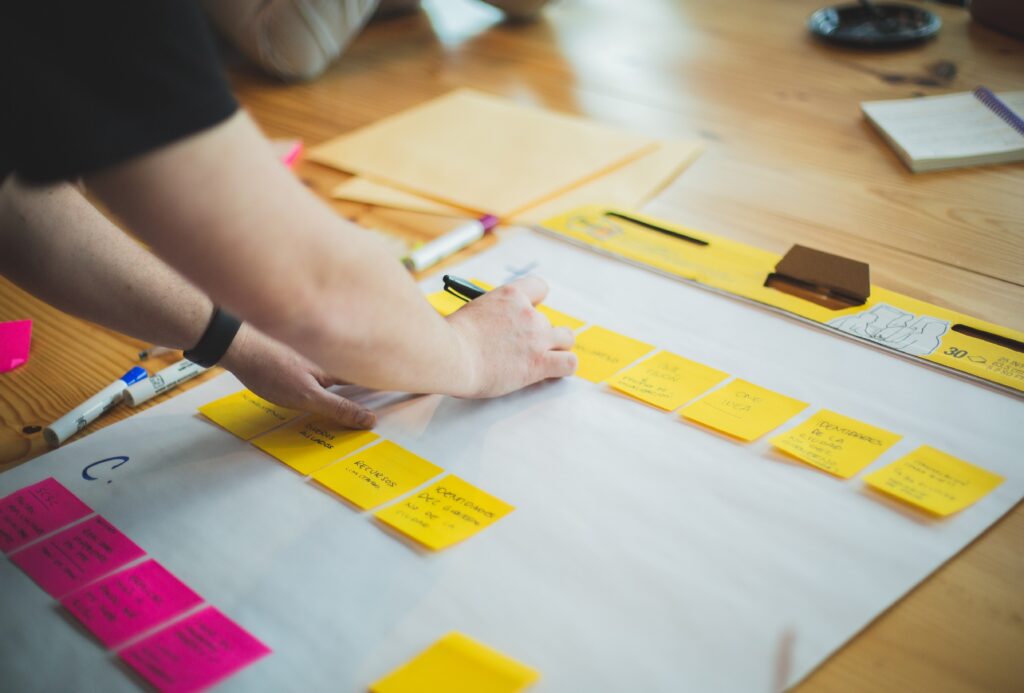What is a theory of change, and why do you need it?
This is a guide for anyone who wants to learn about or create a theory of change. It describes our approach to theories of change, why you may want one, and how to get started with yours.

What is a theory of change?
A theory of change is a diagram that shows how a project, a programme or an organisation create (or aim to create) positive social change. If needed, the theory of change diagram can also be complemented by a written document.
A theory of change diagram is usually broken down into key steps for change.
At Renaisi, we think that the most useful four steps to include in a theory of change are generally:
- Activities – What people do as part of the project (e.g., deliver mentoring sessions, host community events, etc.)
- Mechanisms of change – The tangible and intangible elements needed to turn activities into outcomes. In other words, what makes the difference between an activity that produces positive change and one that does not? That could be about enough people engaging in certain activities, about staff having the right skills and enough capacity, etc.
- Outcomes – The expected changes a project will create in the longer term.
- Impact – A shared vision beyond what the project can achieve on its own. If your project represents one piece of a bigger puzzle, what does the puzzle look like?
To kick-start our theory of change workshops and make the idea more tangible for clients, we often create a theory of change for ‘making coffee’.
This is what your simple making coffee theory of change could look like:
| Activities | Mechanisms of change | Outcomes |
|---|---|---|
| What steps do you take to make a coffee? | What elements are key to a good coffee? | Why do you drink coffee? |
| – Boil water – Crush coffee beans – Add milk | – Good quality beans – Fresh milk – A nice mug | – For energy – For the taste – To socialise |
Of course, the factors for making the ‘perfect’ coffee will vary by individual, ingredients and situation. Just as the activities, elements and outcomes will vary for any organisation or service.
You may come across theories of change that show:
- inputs (ie the resources needed to deliver activities)
- outputs (ie the tangible and direct results of your activities)
- different stakeholders’ inputs and outcomes
- assumptions
- arrows between the different steps to show the sequencing of activities or causal links between steps
- short-term and long-term outcomes
- unintended impact
- and more!
Do not feel overwhelmed by that list. The best thing about theories of change is that they are unique. They can be developed in a way that is most useful to you and your goals.
It could be simple or complex, lengthy or succinct, aspirational or backed by evidence. The arrows and boxes can fly around and feel free to play with colours!
What matters most, is that your theory of change works for you, your project, programme or organisation.
Who needs a theory of change and why?

Theories of change can be useful to all sorts of people. We commonly create them with charities, trusts & foundations, local government teams, and local community members.
Theory of Change processes should ideally be collaborative. The process can bring together people who do not often interact and may have developed different views of a programme or organisation over time. That process of collaboration can be powerful – and helps encourage all involved to agree on how change happens.
Theories of Change are also useful when those stakeholders need to set out a clear vision for change and map out the steps to get there. Your organisation may have a clear idea about the difference you wish to make in the world – for instance helping girls & young women thrive – but you may not know clearly how to achieve that. Developing a theory of change with your colleagues and the girls & young women you support can help you get clarity.
Alternatively, your team may have lots of brilliant suggestions about what your organisation should do, without being clear on what unites them all. A theory of change can help you all think about your wider purpose and ask important questions that help prioritise activities.
Theories of Change are great tools to communicate clearly and visually about your project, programme or organisation to external audiences – whether that’s the public, funders, potential participants or partner organisations.
And last but not least, Theories of Change are key when it comes to evaluation. Evaluators use Theories of Change to know what outcomes to measure, what mechanisms of change to test, or what activities to monitor. They are a key starting point to developing evaluation frameworks, and deciding what data you will need to collect, from who and when.
In conclusion
If you’re looking for a succinct way to describe the change you aim to make, that unites colleagues and helps you focus on priorities then you should seriously consider developing a theory of change. If you’d like some help, please get in touch.

- Want to find out more?
- Contact Mylene Pacot on:
- 07564959248
- m.pacot@renaisi.com

